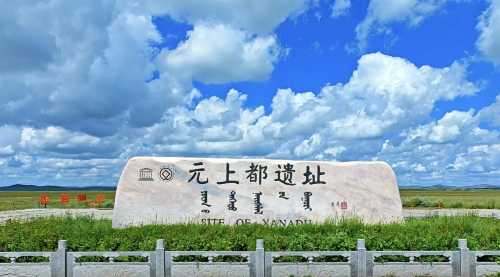Popular Trip Moments
Yuan Shangdu Ruins: Understand How China Influenced the World Through an 800-Year Journey | A Must-Do in This Lifetime! The Great Hunsandake Desert Self-Drive Grand Loop! | The starry sky in November is spectacular, a stargazing study tour in Xilingol | The Hunshandake Ice and Snow Adventure Heats Up Xilingol's Winter Tourism | Step into the vast grasslands of Xilingol this summer and embark on a stargazing study tour | Xilingol League Dragon Raising Head Six Provinces and Cities Ice and Snow Crossing Exciting "Engine" Kickoff! | A cultural journey in Zhenglan Banner, a treasure route 99% of people don't know about | Life advice: You must drive through the Hunshandake Grand Loop at least once | Travel Inner Mongolia's Xilingol League with the variety show "Joyful Journey"! | No More Fragile College Students! 18 Universities Compete in the Ice Dragon Boat Race | Unlock the exciting winter activities in Xilingol League and ignite your passion for winter! | 4-day, 3-night group tour, outdoor exploration of Xilingol's volcanic grassland and sandy land | Come to Xilingol League after your exam! Enjoy surprise discounts with your admission ticket! | National Day Self-Drive Autumn Tour | G207 Xilingol Section, Beautiful Everywhere You Go | Spring Camping on the Great Grasslands: Encounter the Perfect Spring Scenery! | Ulan Butong-Dada Line 5-Day Tour: A Comprehensive Guide, Avoid the Pitfalls | The soul-touching Huimei of Nezha 2 is in Jinlianchuan Grassland of Ximeng League! | Jinlian River: The air is filled with the fragrance of "chrysanthemum tea"! | If you want to go to the lake on the prairie, go to Shangdu Lake! | 【Explore the ancient times and search for the Yuan Dynasty】Yuan Shangdu Ruins Museum | 【Exploring the Ancient Yuan Dynasty】Yuan Shangdu Ruins
Recommended Attractions at Popular Destinations
Popular Attractions in Sydney | Popular Attractions in Dubai | Popular Attractions in Paris | Popular Attractions in Shanghai | Popular Attractions in Phuket | Popular Attractions in New York | Popular Attractions in Tokyo | Popular Attractions in Bali | Popular Attractions in Melbourne | Popular Attractions in West Lake | Popular Attractions in Iguazu National Park(Argentina) | Popular Attractions in London | Popular Attractions in Rome | Popular Attractions in Kuala Lumpur | Popular Attractions in Chefchaouene | Popular Attractions in Singapore | Popular Attractions in Kyoto | Popular Attractions in Los Angeles | Popular Attractions in Zanzibar Island | Popular Attractions in Las Vegas | Popular Attractions in Osaka | Popular Attractions in Walt Disney World Resort | Popular Attractions in Beijing | Popular Attractions in Bangkok | Popular Attractions in Barcelona | Popular Attractions in Chengdu | Popular Attractions in Florence | Popular Attractions in Madrid | Popular Attractions in Jungfrau Region | Popular Attractions in Istanbul
Popular Restaurants in Zhenglan Banner
格日勒茶楼(乃日音希热街店) | 清真·伊源盛鼎莜面骨头私房菜 | 都勒根野奢游牧营地·都勒根野奢餐厅 | 灶座小锅烀饼·铁锅炖(内蒙古总店) | 顺心喜庆楼 | 可汗塔拉蒙餐 | 锡林郭勒蒙古大营 | 锡盟羔火锅(乃日音希热街店) | 张亮麻辣烫(二校店) | 正宗兰州拉面(百货大楼东) | 金驼肉饼城 | Huaqiangu | 苗家饺子(蓝都花园店) | 驴福记金牌驴肉火烧(正兰旗店) | 米多米早餐店 | 奥香居蛋糕(福客多购物城店) | 正蓝旗草原特蒙餐 | 草原羔羊火锅 | 胡同老火锅 | 草原狼烧烤吧(侍郎城路店) | 德克士(正蓝旗店) | 华莱士·全鸡汉堡(正蓝旗元都店) | 大众莜面骨头馆 | 铁锅柴火锅(宝恩巴胡同店) | Jingdongroubing | 贝加尔布里亚特风味餐厅(蓝都花园店) | 聚湘苑涮府 | 山西刀削面 | 穆顺斋 | 牧之乡蓝旗特产店
Popular Ranked Lists
Popular Luxury Hotels Near Greenville County | Popular Luxury Hotels in Versailles | Top 20 Must-Visit Restaurants in Shangrao | Top 50 Luxury Hotels near Chichester | Top 20 Must-Visit Restaurants in Yangshuo | Popular Premium Hotels in Volarice | Top 20 Must-Visit Restaurants in Nagoya | Top 10 Luxury Hotels near Arapahoe County | Top 10 Local Restaurants in Lushan Global Geopark | Popular Premium Hotels in Shodoshima | Top 20 Must-Visit Restaurants in Shaoxing | Popular Trending Attractions in Shaoxing | Popular Trending Attractions in Yichang | Top 20 Must-Visit Restaurants in Jingdezhen | Popular Premium Hotels in Hammamet Sud | Top 20 Must-Visit Restaurants in Taiyuan | Popular Premium Hotels in Opcina Zupa Dubrovacka | Popular Premium Hotels in Calangute | Top 10 Trending Attractions in Zibo | Popular Luxury Hotels in Le Puy-Sainte-Reparade | Top 50 Luxury Hotels near Pandaan | Top 10 Must-Visit Restaurants in Xishuangbanna | Popular Premium Hotels in Leukerbad | Popular Trending Attractions in Toyako | Popular Premium Hotels in Valles Oriental | Popular Trending Attractions in Rizhao | Popular Premium Hotels in Guimaraes | Top 10 Trending Attractions in Sapporo | Top 20 Must-Visit Restaurants in Venice | Top 50 Must-Visit Restaurants in Foshan
About
Payment methods
Our partners
Copyright © 2025 Trip.com Travel Singapore Pte. Ltd. All rights reserved
Site Operator: Trip.com Travel Singapore Pte. Ltd.
Site Operator: Trip.com Travel Singapore Pte. Ltd.












